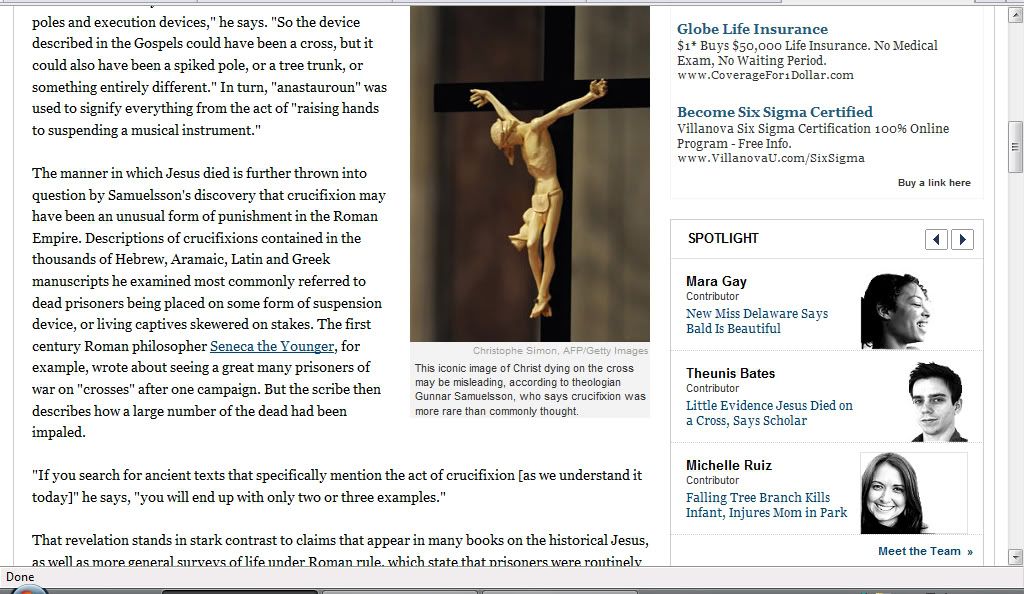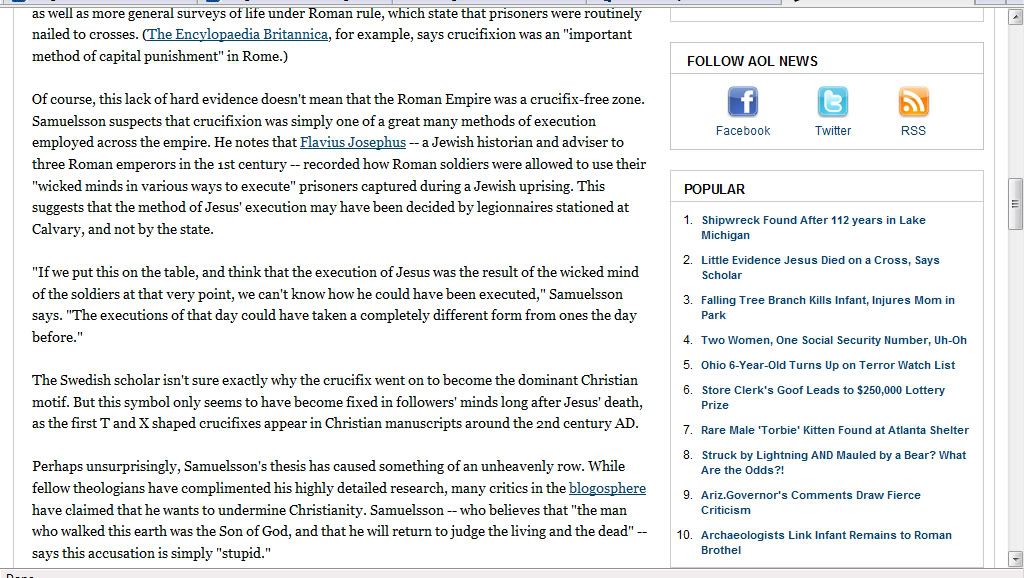before aol decides it's "too controversial" and is paid to take it down...
Saw this in the news yesterday. Although not surprised at the main content, I AM surprised this has been published openly.
Little Evidence Jesus Died on a Cross, Says Scholar
(June 27) -- The crucifix is the defining symbol of Christianity, a constant reminder to the faithful of the sacrifice and suffering endured by Jesus Christ for humanity. But an extensive study of ancient texts by a Swedish pastor and academic has revealed that Jesus may not have died on a cross, but instead been put to death on another gruesome execution device.
Gunnar Samuelsson -- a theologian at the University of Gothenburg and author of a 400-page thesis on crucifixion in antiquity -- doesn't doubt that Jesus died on Calvary hill. But he argues that the New Testament is in fact far more ambiguous about the exact method of the Messiah's execution than many Christians are aware.
"When the Gospels refer to the death of Jesus, they just say that he was forced to carry a "stauros" out to Calvary," he told AOL News. Many scholars have interpreted that ancient Greek noun as meaning "cross," and the verb derived from it, "anastauroun," as implying crucifixion. But during his three-and-a-half-year study of texts from around 800 BC to the end of the first century AD, Samuelsson realized the words had more than one defined meaning.
Gunnar Samuelsson says the New Testament is far more ambiguous about the exact method of Jesus' execution than many Christians are aware.
Christophe Simon, AFP/Getty Images
This iconic image of Christ dying on the cross may be misleading, according to theologian Gunnar Samuelsson, who says crucifixion was more rare than commonly thought.
"'Stauros' is actually used to describe a lot of different poles and execution devices," he says. "So the device described in the Gospels could have been a cross, but it could also have been a spiked pole, or a tree trunk, or something entirely different." In turn, "anastauroun" was used to signify everything from the act of "raising hands to suspending a musical instrument."
The manner in which Jesus died is further thrown into question by Samuelsson's discovery that crucifixion may have been an unusual form of punishment in the Roman Empire. Descriptions of crucifixions contained in the thousands of Hebrew, Aramaic, Latin and Greek manuscripts he examined most commonly referred to dead prisoners being placed on some form of suspension device, or living captives skewered on stakes. The first century Roman philosopher Seneca the Younger, for example, wrote about seeing a great many prisoners of war on "crosses" after one campaign. But the scribe then describes how a large number of the dead had been impaled.
"If you search for ancient texts that specifically mention the act of crucifixion [as we understand it today]" he says, "you will end up with only two or three examples."
That revelation stands in stark contrast to claims that appear in many books on the historical Jesus, as well as more general surveys of life under Roman rule, which state that prisoners were routinely nailed to crosses. (The Encylopaedia Britannica, for example, says crucifixion was an "important method of capital punishment" in Rome.)
Of course, this lack of hard evidence doesn't mean that the Roman Empire was a crucifix-free zone. Samuelsson suspects that crucifixion was simply one of a great many methods of execution employed across the empire. He notes that Flavius Josephus -- a Jewish historian and adviser to three Roman emperors in the 1st century -- recorded how Roman soldiers were allowed to use their "wicked minds in various ways to execute" prisoners captured during a Jewish uprising. This suggests that the method of Jesus' execution may have been decided by legionnaires stationed at Calvary, and not by the state.
"If we put this on the table, and think that the execution of Jesus was the result of the wicked mind of the soldiers at that very point, we can't know how he could have been executed," Samuelsson says. "The executions of that day could have taken a completely different form from ones the day before."
The Swedish scholar isn't sure exactly why the crucifix went on to become the dominant Christian motif. But this symbol only seems to have become fixed in followers' minds long after Jesus' death, as the first T and X shaped crucifixes appear in Christian manuscripts around the 2nd century AD.
Perhaps unsurprisingly, Samuelsson's thesis has caused something of an unheavenly row. While fellow theologians have complimented his highly detailed research, many critics in the blogosphere have claimed that he wants to undermine Christianity.*** Samuelsson -- who believes that "the man who walked this earth was the Son of God, and that he will return to judge the living and the dead" -- says this accusation is simply "stupid."
"I'm really just a boring, conservative pastor and I start everyday reading the New Testament," he says. "But my suggestion is that we should read the text as it is, not as we think it is."
***(My note) Or maybe he's just exposing one of the myths of Church Doctrine. I can think of 6 off the top of my head. Perhaps The Bible needs to be examined just as that priest says at the end. "...read the text as it is, not as we think it is." There's a big difference.
To prove I am not making this up, I have taken screencaps of this.




Little Evidence Jesus Died on a Cross, Says Scholar
(June 27) -- The crucifix is the defining symbol of Christianity, a constant reminder to the faithful of the sacrifice and suffering endured by Jesus Christ for humanity. But an extensive study of ancient texts by a Swedish pastor and academic has revealed that Jesus may not have died on a cross, but instead been put to death on another gruesome execution device.
Gunnar Samuelsson -- a theologian at the University of Gothenburg and author of a 400-page thesis on crucifixion in antiquity -- doesn't doubt that Jesus died on Calvary hill. But he argues that the New Testament is in fact far more ambiguous about the exact method of the Messiah's execution than many Christians are aware.
"When the Gospels refer to the death of Jesus, they just say that he was forced to carry a "stauros" out to Calvary," he told AOL News. Many scholars have interpreted that ancient Greek noun as meaning "cross," and the verb derived from it, "anastauroun," as implying crucifixion. But during his three-and-a-half-year study of texts from around 800 BC to the end of the first century AD, Samuelsson realized the words had more than one defined meaning.
Gunnar Samuelsson says the New Testament is far more ambiguous about the exact method of Jesus' execution than many Christians are aware.
Christophe Simon, AFP/Getty Images
This iconic image of Christ dying on the cross may be misleading, according to theologian Gunnar Samuelsson, who says crucifixion was more rare than commonly thought.
"'Stauros' is actually used to describe a lot of different poles and execution devices," he says. "So the device described in the Gospels could have been a cross, but it could also have been a spiked pole, or a tree trunk, or something entirely different." In turn, "anastauroun" was used to signify everything from the act of "raising hands to suspending a musical instrument."
The manner in which Jesus died is further thrown into question by Samuelsson's discovery that crucifixion may have been an unusual form of punishment in the Roman Empire. Descriptions of crucifixions contained in the thousands of Hebrew, Aramaic, Latin and Greek manuscripts he examined most commonly referred to dead prisoners being placed on some form of suspension device, or living captives skewered on stakes. The first century Roman philosopher Seneca the Younger, for example, wrote about seeing a great many prisoners of war on "crosses" after one campaign. But the scribe then describes how a large number of the dead had been impaled.
"If you search for ancient texts that specifically mention the act of crucifixion [as we understand it today]" he says, "you will end up with only two or three examples."
That revelation stands in stark contrast to claims that appear in many books on the historical Jesus, as well as more general surveys of life under Roman rule, which state that prisoners were routinely nailed to crosses. (The Encylopaedia Britannica, for example, says crucifixion was an "important method of capital punishment" in Rome.)
Of course, this lack of hard evidence doesn't mean that the Roman Empire was a crucifix-free zone. Samuelsson suspects that crucifixion was simply one of a great many methods of execution employed across the empire. He notes that Flavius Josephus -- a Jewish historian and adviser to three Roman emperors in the 1st century -- recorded how Roman soldiers were allowed to use their "wicked minds in various ways to execute" prisoners captured during a Jewish uprising. This suggests that the method of Jesus' execution may have been decided by legionnaires stationed at Calvary, and not by the state.
"If we put this on the table, and think that the execution of Jesus was the result of the wicked mind of the soldiers at that very point, we can't know how he could have been executed," Samuelsson says. "The executions of that day could have taken a completely different form from ones the day before."
The Swedish scholar isn't sure exactly why the crucifix went on to become the dominant Christian motif. But this symbol only seems to have become fixed in followers' minds long after Jesus' death, as the first T and X shaped crucifixes appear in Christian manuscripts around the 2nd century AD.
Perhaps unsurprisingly, Samuelsson's thesis has caused something of an unheavenly row. While fellow theologians have complimented his highly detailed research, many critics in the blogosphere have claimed that he wants to undermine Christianity.*** Samuelsson -- who believes that "the man who walked this earth was the Son of God, and that he will return to judge the living and the dead" -- says this accusation is simply "stupid."
"I'm really just a boring, conservative pastor and I start everyday reading the New Testament," he says. "But my suggestion is that we should read the text as it is, not as we think it is."
***(My note) Or maybe he's just exposing one of the myths of Church Doctrine. I can think of 6 off the top of my head. Perhaps The Bible needs to be examined just as that priest says at the end. "...read the text as it is, not as we think it is." There's a big difference.
To prove I am not making this up, I have taken screencaps of this.



